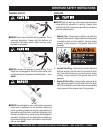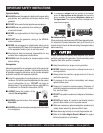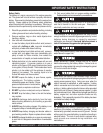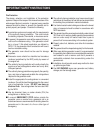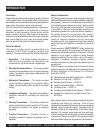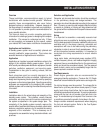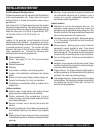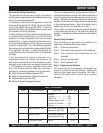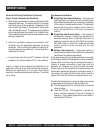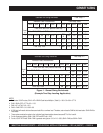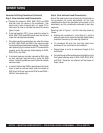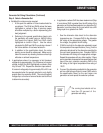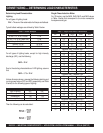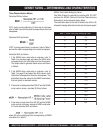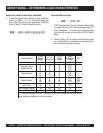
INDUSTRIAL GENERATOR SETS — APPLICATION & INSTALLATION MANUAL — REV. #4 (09/07/07) — PAGE 17
GENSET SIZING
Generator Set Sizing Calculations
The generator set must be sized to supply the maximum
starting (power surge) demands and the steady-state running
loads of the connected equipment.
It is important to have the correct generator to meet the
demands of the starting kVA (SkVA), starting kW (SkW),
running kVA (RkVA) and running kW (RkW). A value for
generator kW (GkW) is also obtained when nonlinear loads
are included in the sizing calculation.
Once the starting and running loads have been determined,
it is typical to add a margin factor of up to 25% for future
expansion or to select a generator set of the next largest
standard rating. A large connected load that does not run
during usual power outages, such as a fire pump, can serve
as part of a margin factor. For a fuel efficiency standpoint,
the running load should stay within approximately 50 to 80%
of the generator kW rating. To avoid "wet stacking", the
running load should not be less than 30% of the generator
set rating.
It may be necessary to oversize a generator set in
applications where the voltage and frequency dip
performance specifications are more stringent than usual,
particularly when large motors are started across-the-line
or UPS equipment is involved. Applications that involve
any of the following nonlinear loads may also make it
necessary to oversize the generator set or the generator:
Static Uninterrupted Power Supplies (UPS)
Battery Charging Rectifiers (Telecommunications)
Variable Frequency Drives (VFD)
Medical Diagnostic Imaging Equipment
Genset Sizing Procedure
When calculating the generator size needed for the
application, consider the following procedure:
Step 1. Prepare a load schedule
Step 2. Enter loads in step sequence on the worksheet
Step 3. Enter individual load characteristics on the
worksheet
Step 4. Find the load step totals
Step 5. Select a generator set
Step 1. Prepare a Load Schedule
All the loads that will be connected to the generator set
should be recorded on the load schedule. Identify each
load as to type, power rating, and quantity. See Table 1
below for the loads listed (in
italics
) for an example
calculation.
The use of closed-transition autotransformer starters for
reduced voltage starting of large motor loads will reduce the
size of the generator set required relative to across-the-line
starting. Resistor-type reduced-voltage motor starting may
actually increase the size of the generator set required due
to high starting power factors. Wound rotor motors are the
easiest type of motor for a generator set to start.
The first step is to create a reasonably accurate schedule
of connected loads as early in the preliminary design as
possible. A sample load schedule sheet can be found below
on Table 1.
eludehcSdaoL.1elbaT
#daoLnoitpircseDdaoLdaoLfoepyTgnitaRrewoP.YTQdaoL
:selpmaxE
Wk...................................gnithgiL
AVk..............................SPUcitatS
PH............sevirDdeepSelbairaV
AVk.............srefitceRCDmoceleT
PH.....................................srotoM
1
2#&1#spmuPretaW,GretteledoCameN,rotoM
)paT%08(retratsremrof
PH001
2
2
3#spmuPretaW,GretteledoCameN,rotoM
)paT%08(retratsremrof
PH001
1
3
gnithgiLtnecsroulFgnithgiLPH01
1



